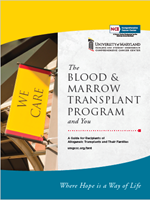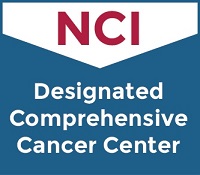Allogeneic Transplant
Greenebaum Cancer Center - Allogeneic Transplant Clinic
22 S. Greene Street
9th Floor
Baltimore, MD 21201
About
What is allogeneic transplant?
In an allogeneic transplant, the patient receives bone marrow or peripheral blood stem cells from another person -- usually a sibling, but sometimes an unrelated donor. This is different from an autologous transplant in which some of the patient's own marrow or peripheral blood stem cells are removed, treated and then given back.
When is bone marrow or peripheral blood stem cell transplant an appropriate treatment?
Bone marrow/peripheral blood stem cell transplant is used to treat a number of life-threatening diseases. Transplant has also become the standard of care in certain diseases. The procedure offers hope of a cure when standard cancer treatment has not been able to destroy all of the cancer cells. The patient's body can withstand higher -- and possibly more effective -- doses of chemotherapy and/or radiation when bone marrow function can be bolstered with fresh bone marrow and/or stem cells.
Some of the diseases for which bone marrow/peripheral blood stem cell transplant may be used are: Hodgkin's disease, Non-Hodgkin's lymphoma, multiple myeloma, acute leukemia, chronic leukemia, aplastic anemia, and myelodysplastic syndromes. Transplants may also be used in the treatment of breast cancer, ovarian cancer, testicular cancer, sarcomas and brain tumors.
What is the difference between bone marrow and peripheral blood stem cell transplant?
Bone marrow is the spongy tissue found inside the bones. Bone marrow makes stem cells, which grow and divide and become red blood cells (which carry oxygen to body tissues), white blood cells (which help fight off infection), and platelets(which aid in blood clotting). Stem cells are found in the blood stream, normally at low concentrations. However, the number of stem cells in the peripheral blood can be increased by giving a donor a "growth factor."
In a bone marrow transplant, some marrow (about 5 percent) is "harvested" from the donor's hip bone in a surgical procedure that lasts about an hour and requires general anesthesia. These cells are pooled, processed and transfused into the patient.
Peripheral stem cells, on the other hand, can be taken from the blood circulating in the body after the donor is injected with a growth factor called Granulocyte Colony Stimulating Factor (G-CSF ). This medication stimulates the donor's bone marrow to produce excess quantities of stem cells which are released into the circulating blood. The donor's blood is drawn and a special blood processing system concentrates the stem cells. These cells are transfused into the patient. The donor experiences no surgical pain.
Peripheral blood stem cell transplant generally provides more stem cells and results in a more rapid recovery of white blood cells and platelets. However, it may be associated with a higher risk of chronic graft vs. host disease.
How are transplant recipients selected?
Possible recipients are carefully evaluated to determine if transplant is the best treatment option. Some of the criteria considered are age, overall medical status, type and stage of disease, and disease progression. Your transplant team will thoroughly discuss all of the risks and benefits with you and your family.
Who can be a donor?
Anyone whose blood "antigens" match yours -- and who is otherwise healthy -- can be a donor. But finding that person can be a challenge. There may be a match in your own family (siblings or, less likely, a parent or child may share your genetic make-up). If a match is not found within your family, a search begins within the general population. The Blood and Marrow Transplant (BMT) Program is a member of the National Marrow Donor Program (NMDP) which has more than 2.5 million volunteer donors who have been typed. There are also other smaller national and international registries. Your transplant coordinator can give you more information about the search process.
How are donors matched?
A small sample of blood taken from the potential donor is compared with your blood through a series of tests. Cells have structures on their surface called human leukocyte antigens, or HLAs, which recognize whether cells belong to the body or are foreign. When your antigen sites match those of a donor, your body is less likely to see the person's blood cells as foreign and reject them.
HLA tissue typing continues to improve. Today, sophisticated lab techniques are producing much better matches for unrelated donor transplants. The University of Maryland has one of the most advanced HLA labs in the country, the American Red Cross National HLA Laboratory.
What determines if a "match" will be successful?
The closer the match, the more likely the donated bone marrow or peripheral blood stem cells will be accepted into your body. Even with close HLA matches, subtle differences in other structures on the cell membrane may cause rejection (your immune system attacks the bone marrow cells) or graft vs. host disease (the donor's immune system attacks your body). A number of new drugs are helping to counteract graft vs. host disease. These medications have made it possible for some less-than-perfect matches to succeed.
How is an allogenic peripheral blood stem cell transplant performed?
At the University of Maryland Marlene and Stewart Greenebaum Cancer Center (UMGCCC), allogenic peripheral blood stem cells transplants may be an option only if the donor is related to you. If the donor is unrelated to you, you will receive a bone marrow transplant instead.
For a peripheral blood stem cell transplant, a related donor comes to the hospital the day of the transplant. Through a process called apheresis, the donor's blood is removed through a vein in the arm or through a catheter inserted into a large vein in the neck or chest area. The blood is circulated through special machine that collects the stem cells. The blood is then returned to donor and the stem cells are stored. Apheresis typically takes 4-5 hours to complete. While about 20-30 units of blood are processed during apheresis, only about one unit of blood is outside the body at any given time. The collected stem cells are processed and frozen until they are transplanted back to the patient.
There is a possibility that bone marrow may need to be harvested from the donor to obtain enough stem cells for the transfusion. The transplant team will keep you fully informed.
For a bone marrow transplant, bone marrow will be collected from the donor under general anesthesia in an operating room. Approximately one liter (two pints) of bone marrow will be removed from the hip bones in the back through multiple aspirations. The procedure lasts about 90 minutes.
If the donor is unrelated to the recipient and does not live nearby, the bone marrow is collected at a facility near where the donor lives. The cells are then frozen and delivered by special medical courier for transfusion to the transplant recipient.
What happens after the bone marrow or stem cells have been transplanted to the patient?
After entering the bloodstream, the transplanted cells travel to the bone marrow, where they begin to produce new white blood cells, red blood cells and platelets. This process is called "engraftment." It may take 10-16 days for engraftment to occur after transplantation. Doctors monitor whether new blood cells are being produced by checking blood counts daily. Periodic bone marrow aspirations (the removal of a small sample of bone marrow through a needle for examination under a microscope) can also help doctors determine if engraftment has been successful.



